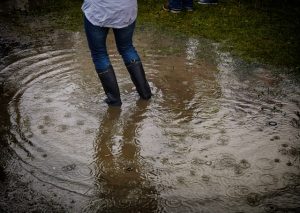
Before buying a new house in Florida, you must look for past damages. Some homes survive extreme weather conditions, which leaves them with permanent consequences on the build and stability. That’s why you should do a home inspection to check whether your new house has ever been flooded. By doing so, you will not only find out about possible damages but also future risks. In this article, we’ll tell you exactly how to check whether your Florida home has ever been flooded.
Consult The Paperwork
The first thing you can do to check whether your Florida home has ever been flooded is to read the real estate paperwork. Examine all documents relevant to the property’s condition. Read the prior owner’s disclosures as well as any inspection reports from inspectors you hired.
Suppose the house has a history of flood damage. In that case, you’ll have to decide between dropping out of the sale or taking specific measures before hurricane season for as long as you live there.
Find Out If the House Is in The Flood Zone
 Before buying a house, check if it’s located in a high-risk zone of being flooded. To get started, go to FEMA’s website and type in your address to see the closest, most relevant flood map in your area. If you’re dealing with an empty lot that doesn’t have a registered address, locate the next property that does and search for it. If you determine your property is in a medium or high-risk location, you should purchase flood insurance and further investigate whether the property has any signs of flooding.
Before buying a house, check if it’s located in a high-risk zone of being flooded. To get started, go to FEMA’s website and type in your address to see the closest, most relevant flood map in your area. If you’re dealing with an empty lot that doesn’t have a registered address, locate the next property that does and search for it. If you determine your property is in a medium or high-risk location, you should purchase flood insurance and further investigate whether the property has any signs of flooding.
Why Should You Check the Property for Signs of Flooding?
Floods can cause costly damages to a home. Damage from a flood might require everything from new foundations, floors, walls, wiring, and plumbing to new clothes and appliances. People’s entire basements and houses get flooded. Those who store their heirlooms and other keepsakes in the basement usually end up losing their treasured items. While this is avoidable by following simple storing tips like the ones you can find on bestmoversinflorida.com, it’s still tragic when it happens. To avoid it, you should always check whether your Florida home has ever been flooded.
Check For Cracks in The Foundation
 Floodwaters wreak havoc on home foundations. Damaged foundations compromise a building’s structural integrity. To check for damage, walk around the property and look for cracks in the stone, concrete, or brick foundation.
Floodwaters wreak havoc on home foundations. Damaged foundations compromise a building’s structural integrity. To check for damage, walk around the property and look for cracks in the stone, concrete, or brick foundation.
Checking the contours of the soil outside the home is another trick you can use. Pay close attention to the details. It could be a sign of earlier floods if the ground is flat and then lowers a few inches unexpectedly.
Search For Signs of Water Damage
The next step you can take is to search for signs of water damage on the basement walls. Bring a flashlight with you to get a better look. Tell-tale signs of water damage are cracks, crumbling, and the smell of mold. An even more obvious sign your basement has been flooded is a yellow line that can sometimes appear on the walls. This means that the basement has not only been flooded, but it lasted long enough to leave a mark where the water was.
Even if your house hasn’t been flooded, checking for water damage should be a part of your regular home maintenance checks. You don’t want your home to have water stains, mold, or mildew.
Look For Damaged Floors
Look for flooring on the property that is twisted, buckled, or cracked. Floods wreak havoc on all kinds of floors, including hardwood, concrete, and linoleum. Some of these are more expensive to replace than others. Moreover, if your house has a history of flooding, you might not want to invest too much in expensive floors and carpets.
Ask The Neighbors
 Another simple way to check for past flooding is to talk to your future neighbors. Ask them if they remember a flooded basement, burst water main, or any other form of disaster. Inquire about clean-up crews visiting your home. Moreover, ask them if they had problems themselves. If your neighbors’ houses often get flooded, your new house might flood too next time.
Another simple way to check for past flooding is to talk to your future neighbors. Ask them if they remember a flooded basement, burst water main, or any other form of disaster. Inquire about clean-up crews visiting your home. Moreover, ask them if they had problems themselves. If your neighbors’ houses often get flooded, your new house might flood too next time.
What If Your House Has Been Flooded?
If you find out your Florida home has a history of flooding, there are a couple of steps you could take. Research flood insurance options to get the best one before moving in your furniture. Moreover, make sure your furniture doesn’t get damaged during relocation. Previously damaged furniture can take up moisture much faster and break much easier. Before moving, hire residential movers who will ensure you move in with ease to ensure your furniture stays intact.
After moving in, take steps to prevent and minimize the effects a flood can have on your home. For example, waterproof your home and install a sump pump. This, along with flood insurance, should have you covered.
In Conclusion
Knowing the history of the house before moving in can sometimes be crucial. If you want to avoid moving into a high-risk home, make sure you do your research and inspect the property. There are plenty of tell-tale signs that make it easier to check whether your Florida home has ever been flooded – you just have to look for them. Sometimes, though, sellers can attempt to hide all the traces of a past flood. In that case, if you’re still suspicious, get flood insurance just in case. The cost can vary based on the risk of flooding in the area. However, it’s better to have it and not need it, than the other way around.
